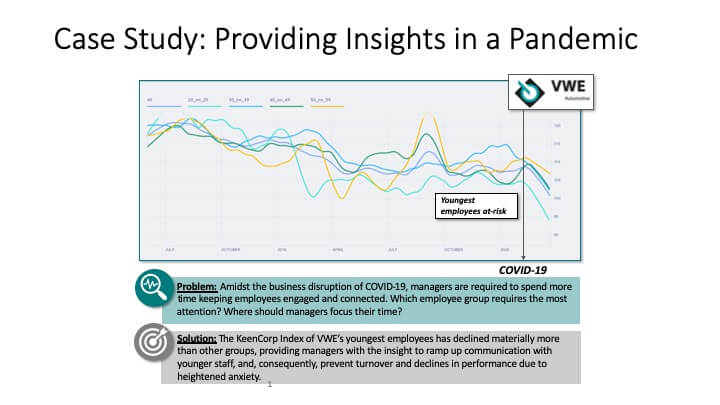Discover how to enhance decision-making in your organization by focusing on three crucial areas: solving the right problem, gathering all the available information, and understanding the intent. Learn to empower your team, foster a purpose-driven culture, and improve organizational clarity for better decision-making.

Employee Mental Health
COVID is causing financial stress for many business owners, and employees and the daily news is not helping that fear go away. This week’s unemployment numbers are sure to cause more heartburn. Also, many of those still working are working from home, which is creating its own set of issues.
Those working from home are putting in longer days on average, approximately three hours, and working on weekends. The extra hours and limited space have destroyed any semblance of work-life balance. The regretful formalities for calling or emailing at inappropriate times has gone by the wayside, and employees are suffering burn out. A month and a half into “work from home,” employees are overworked, stressed, and eager to get back to the office.
While this article focuses on employees, please, as business owners and CEOs, don’t ignore your mental health. Times like this are very stressful, and under severe stress, our mental systems can fail with issues like manic behavior, depression, etc. Make sure you are taking time to meditate, talk to people that understand the pressures you face. If you are not in a Peer CEO Group, like Vistage, get into one today. It will be better for you, your family, and organization to spend that little more than to hospitalized or make bad decisions that destroy your company’s value.
While wake-up times have shifted later due to no community, peak email time has crept up an hour to 9 a.m., according to data from email client Superhuman. However, employees are also logging back in late at night, and spikes in usage from midnight to 3 a.m. are becoming common and were not present before the COVID-19 outbreak. Furthermore, because no one can go out, there’s no escape. With nothing much to do and nowhere to go, people feel like they have no legitimate excuse for being unavailable. “You’re not escaping work,” according to Huda Idrees, CEO of Dot Health, a Toronto-based technology startup.
There is pressure on other employees to prove they’re working, especially with the prospect of layoffs. Employees at Constellation Software Inc. in Toronto, received an email from a superior saying, “Don’t get distracted because you are on your own. It is easy to get into bad habits, the lure of the internet, the endless box sets. Just think, would I do this in the office? If it’s a no, don’t do it.” Earlier the same manager had sent a message saying, “You know we will be watching closely.”
Research and anecdotal evidence points to increased productivity for nearly all of those working from home. However, by early April, about 45% of workers said they were burned out, according to a survey done by Eagle Hill Consulting. To help prevent burnout, some companies are attempting to help people cope through additional leave, free therapy sessions, and virtual meditations.
Regardless of the work-related stress, many other strains are taking a toll on many employees. Their concerns are:
-
their financial situation;
-
continued employment of either them or their partner or both;
-
having the kids home all the time;
-
having parents home all the time, or isolated in a senior living facility;
-
lack of social interaction;
-
the health of kids, parents and others who may not be with them; and
-
state of the country.
Given that everyone now says, “our employees are our greatest assets,” it is time to ensure that your actions match your words. What you do from March to July will be remembered by your employees for the next ten years. It is time to engage with your employees and check-in. By checking in, I don’t just mean a quick, “How are you?” Instead, take time to talk to your direct reports and ask:
-
How are you doing/coping?
-
How are you feeling?
-
Is everyone in your family ok?
-
Is anything wrong?
When doing this, start by telling them how you are doing. Do this regularly during these times. Open up and be vulnerable. Vulnerability creates TRUST! As I mentioned in the piece above, at this time, to capitalize on opportunities from COVID, we need open conflict in our discussion of the way forward. We cannot have that without trust.
You can also use products like Menti’s “Mentimeter,” a free, cloud-based polling tool that allows employees to provide anonymous feedback in response to a prompt. In response to poll to described work-life balance, the aggregated answers are presented in the form of a word cloud and included:
-
Better than ever
-
Non-existent
-
It depends on the day
-
Dream state
-
What work-life balance?
-
I had too many kids
While not identifying who to watch out for, it will indicate how the company is feeling and where the pressures are.
Unfortunately, I have not seen much available on how to measure or deal with employee stress. Googling “employee stress,” I could only find resources from Occupational Health Clinics for Ontario Workers. There was a straightforward survey questionnaire from The American Institute of Stress, which I found limited. I have identified some links dealing with employee stress, which I have listed on my website. Overall this is a sad indictment on the lack of tools for dealing with employee stress.
Severe employee stress is even more problematic when we are all working virtually and communicating by email, Slack, Zoom, or Teams. Stress manifests itself in many ways, but online communication can amplify it, causing the following problems:
- Confusion and doubt
- Bad feelings between people and departments
- Damage to company morale
- Project-completion delays
To prevent these issues, remind employees of how to communicate with others over such channels.
-
To prevent confusion and doubt. Keep your emails short and to the point. Put the most critical information at the top, so your recipient sees it right away. If you have a lot of information to share, skip email altogether and pick up the phone.
-
To prevent bad feelings between people and departments. Unless you know your recipient well, avoid easily misconstrued sarcastic comments. When in doubt, keep it professional. Save the humor for a phone conversation or face-to-face meeting where your recipient can hear and see you.
-
To prevent damaging company morale. Never hit “reply all” or include extra people on a message unless you are sure they need to join the conversation. Only include them in professional topics/issues. Do not argue with other people through email. Don’t try to prove you’re right and someone else is wrong. If it’s that important for you to get everyone involved, then it’s important enough to have a face-to-face group meeting or conference call.
-
To prevent project delays. Make sure your message is easy to understand. Proofread it before you send it. If you are not confident of your skills, use tools like Grammarly. A good check is to ask if you knew nothing about a particular project, would your message help your recipient understand what to do or confuse them.
Also, it is an excellent policy to have everyone on camera when doing video calls. It allows us to make eye contact and read body language. It will be easier to see those that are battling and get them any help sooner. Besides, we see into their lives as we see their homes, and this creates a greater understanding of them than we have had before.
One of my Vistage members mentioned that all their employees are retaking the Culture Index to remind everyone how to treat and communicate with each other. As a rule, “Treat others as they want to be treated.” I like this approach because it acknowledges that not everyone wants to be treated the same way. So I would recommend that everyone do something along those lines, using whatever employee personality test is standard within your organization, i.e., Predictive Index, Culture Index, Emergenetics, etc.
Finally, I recently came across a Dutch company, KeenCorp, which is using AI to analyze digital communication within organizations to measure personal involvement and tension. The results are produced in a single score, and so daily/weekly/monthly changes can be measured, and attention paid to those areas where there are adverse changes – below is an example of their work. I am sure there will be many organizations entering this field, but I think tools like this are bound to help and reduce issues within organizations.

Therefore, if your employees are truly your greatest asset you need to protect them. As I have said above, what you do during this period will be remembered for the next ten years. Take steps to help them cope with stress, show you are vulnerable, remind them how to communicate with each other, encourage work-life balance, and finally, look at other products that can identify issues before they become serious.
Copyright (c) 2020, Marc A. Borrelli
Recent Posts
Boosting Common Sense Decision-Making in Your Organization
Do You Understand Your Costs to Ensure Profitability?
You can only determine profitability when you know your costs. I’ve discussed before that you should price according to value, not hours. However, you still need to know your costs to understand the minimum pricing and how it is performing. Do you consider each jobs’ profitability when you price new jobs? Do you know what you should be charging to ensure you hit your profit targets? These discussions about a company’s profitability, and what measure drives profit, are critical for your organization.
Sunk Costs Are Just That, Sunk!
If you were starting your business today, what would you do differently? This thought-provoking question is a valuable exercise, especially when it brings up the idea of “sunk costs” and how they limit us. A sunk cost is a payment or investment that has already been made. Since it is unrecoverable no matter what, a sunk cost shouldn’t be factored into any future decisions. However, we’re all familiar with the sunk cost fallacy: behavior driven by a past expenditure that isn’t recoupable, regardless of future actions.
Do You REALLY Know Your Business Model?
Bringing clarity to your organization is a common theme on The Disruption! blog. Defining your business model is a worthwhile exercise for any leadership team. But how do you even begin to bring clarity into your operations? If you’re looking for a place to start, Josh Kaufman’s “Five Parts of Every Business” offers an excellent framework. Kaufman defines five parts of every business model that all flow into the next, breaking it down into Value Creation, Marketing, Sales, Value Delivery, and Finance.
Ideation! Harder Than It Sounds
Bringing in new ideas, thoughts, understanding, and logic is key as your organization faces the challenges of a changing environment. But when you do an ideation session in your organization… how does it go? For so many organizations, many times, after a few ideas have been thrown out and rejected, the thought process slows down very quickly, and a form of hopelessness takes over. How does your organization have better ideation? I’ve come across a new approach with a few teams lately.
Recruit, Recruit, Recruit!
An uptick in business has begun this quarter, and companies are rushing to hire to meet this surge in demand. What amazes me is how many are so unprepared to hire. Continual recruiting is key to the survival of a company. It isn’t the same thing as hiring—continuous recruiting is building a pipeline of people that you would hire if you needed to fill a position, or “A players” you would hire if they were available.
We All Need Clarity
If your organization is focused on obscurity over clarity, whether intentionally or not, your “A” player employees are vulnerable. There is a looming talent crunch. As we start to emerge from COVID, demand is increasing, and many are scrambling to fill positions to meet that demand. Headhunters and recruiters are soon going to be calling your key “A” employees. Have you been giving them a reason to stay?
Not Another **** Meeting
As Leonard Bernstein put it so well, “To achieve great things, two things are needed: a plan and not quite enough time.” Your meetings can be shorter, more fruitful, and engaging, with better outcomes for the organization, employees, and managers. It’s time to examine your meeting rhythms and how you set meeting agendas. This week, I break down daily, weekly, monthly, quarterly, annual, and individual meeting rhythms, with sample agendas for each.
Is Your Company Scalable?
Let’s start here: Why should your company be scalable at all? If your business is scalable, you have business freedom–freedom with time, money, and options. Many business leaders get stuck in the “owner’s trap”, where you need to do everything yourself. Sound familiar? If you want a scalable business that gives you freedom, you need to be intentional about what you sell, and how.
Are you ready for the Talent Crunch?
Companies are gearing up to hire. Unfortunately, many are competing within the same talent pool. Some experts are currently predicting a strong economic recovery starting in May or June. But as the economy booms, there is going to be fierce competition for talent. How will you fare in the looming talent crisis? Your organization should be creating a plan, now, so you can attract the talent you need in the year ahead.











